PSY294 - Lab Report: Memory Span and the Impact of Stimulus Type
VerifiedAdded on 2023/06/10
|9
|2251
|405
Report
AI Summary
This PSY294 lab report investigates memory span through an experiment involving the recall of digits, letters, and words. The study aimed to determine if there were significant differences in the length of recollection based on the type of stimuli. 150 university students participated, and a one-way ANOVA test was conducted to analyze the results. The findings indicated significant differences in recall length among the three stimulus types, with digits having the highest average recall length, followed by letters and then words. The discussion explores the potential reasons for these differences, including the impact of prior exposure to words and the accuracy of memory span. The report also supports the claim that short-term memory can hold approximately seven items on average, aligning with established cognitive psychology theories. Desklib provides access to similar solved assignments and past papers for students seeking additional resources.
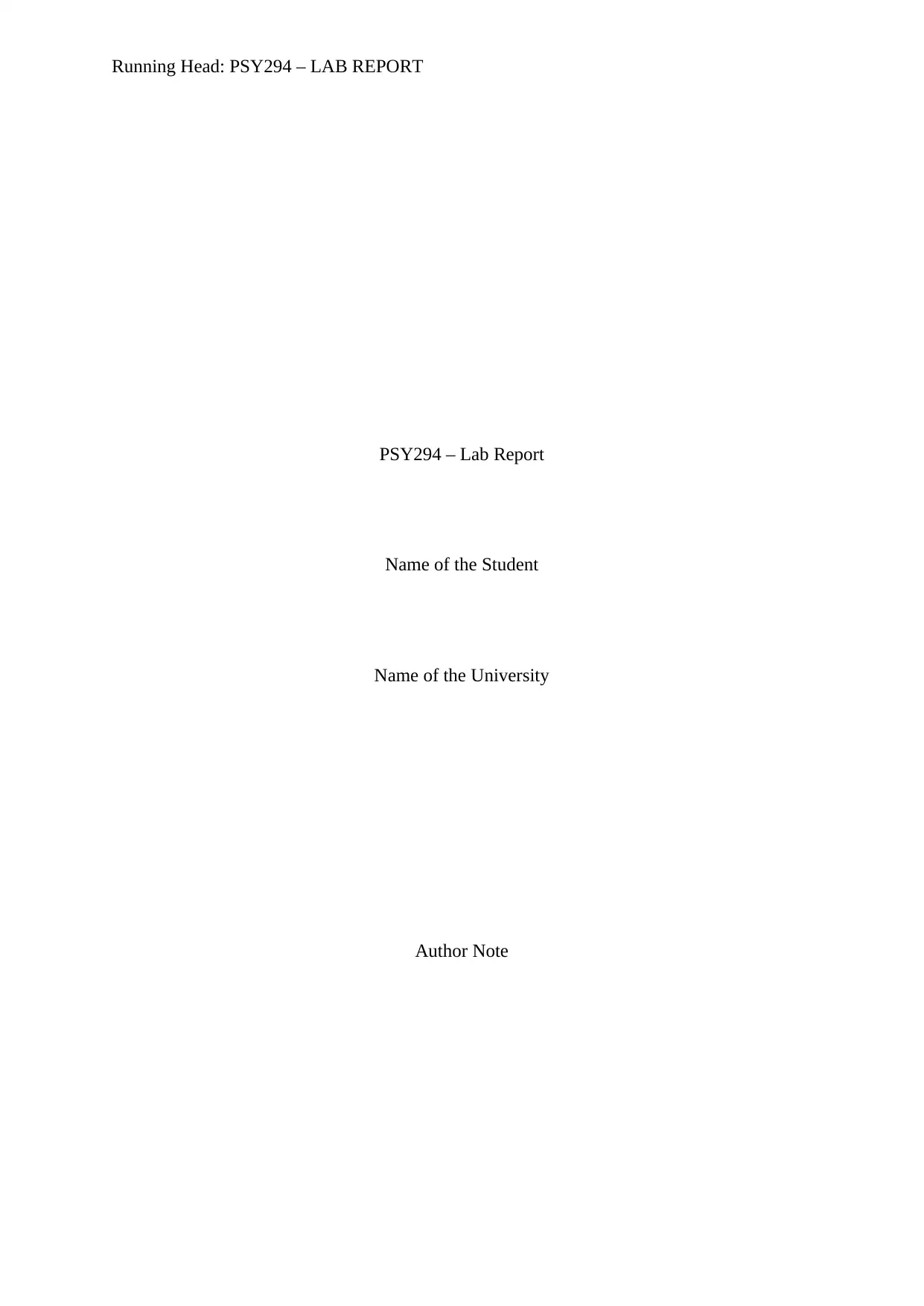
Running Head: PSY294 – LAB REPORT
PSY294 – Lab Report
Name of the Student
Name of the University
Author Note
PSY294 – Lab Report
Name of the Student
Name of the University
Author Note
Paraphrase This Document
Need a fresh take? Get an instant paraphrase of this document with our AI Paraphraser
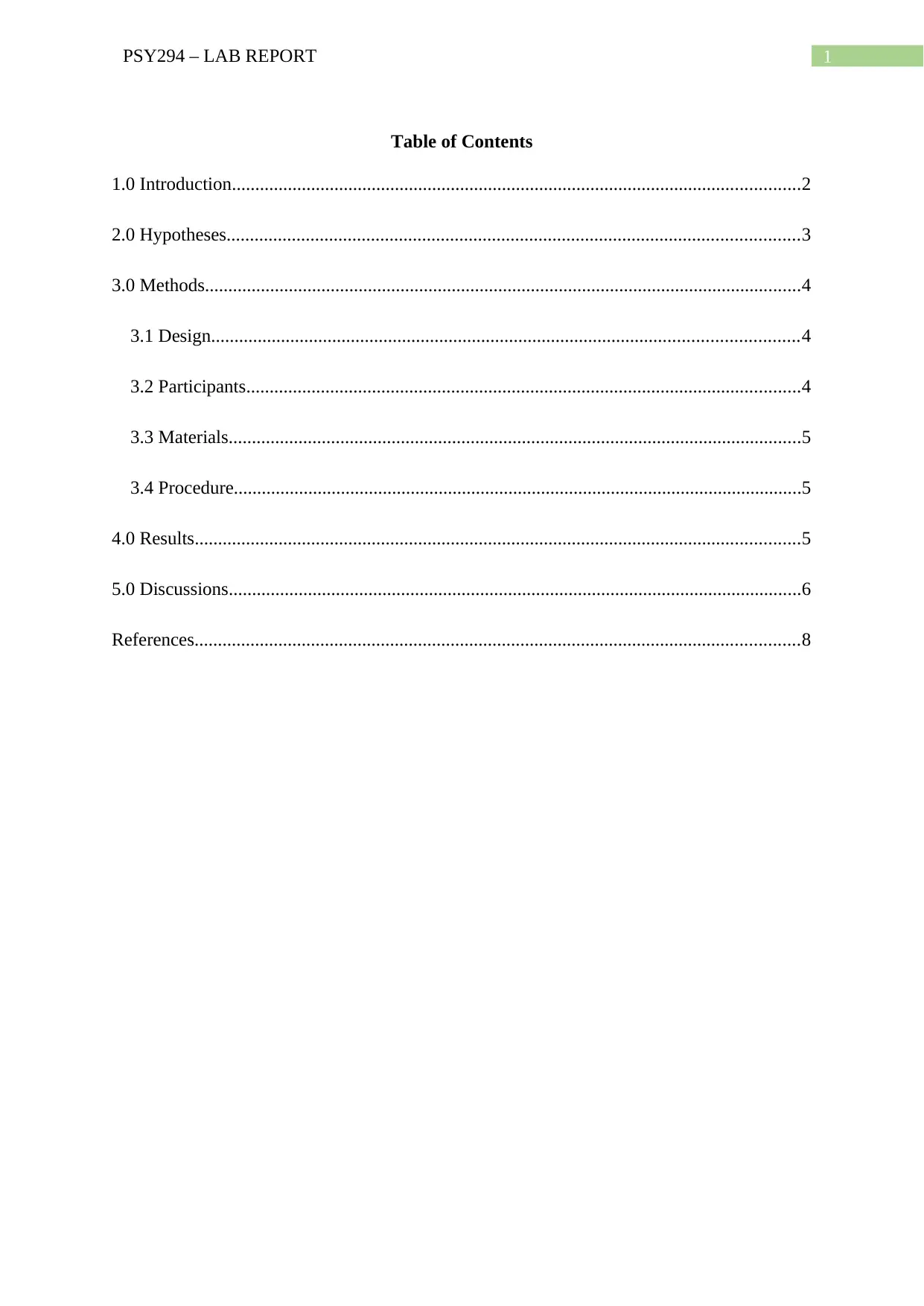
1PSY294 – LAB REPORT
Table of Contents
1.0 Introduction..........................................................................................................................2
2.0 Hypotheses...........................................................................................................................3
3.0 Methods................................................................................................................................4
3.1 Design..............................................................................................................................4
3.2 Participants.......................................................................................................................4
3.3 Materials...........................................................................................................................5
3.4 Procedure..........................................................................................................................5
4.0 Results..................................................................................................................................5
5.0 Discussions...........................................................................................................................6
References..................................................................................................................................8
Table of Contents
1.0 Introduction..........................................................................................................................2
2.0 Hypotheses...........................................................................................................................3
3.0 Methods................................................................................................................................4
3.1 Design..............................................................................................................................4
3.2 Participants.......................................................................................................................4
3.3 Materials...........................................................................................................................5
3.4 Procedure..........................................................................................................................5
4.0 Results..................................................................................................................................5
5.0 Discussions...........................................................................................................................6
References..................................................................................................................................8
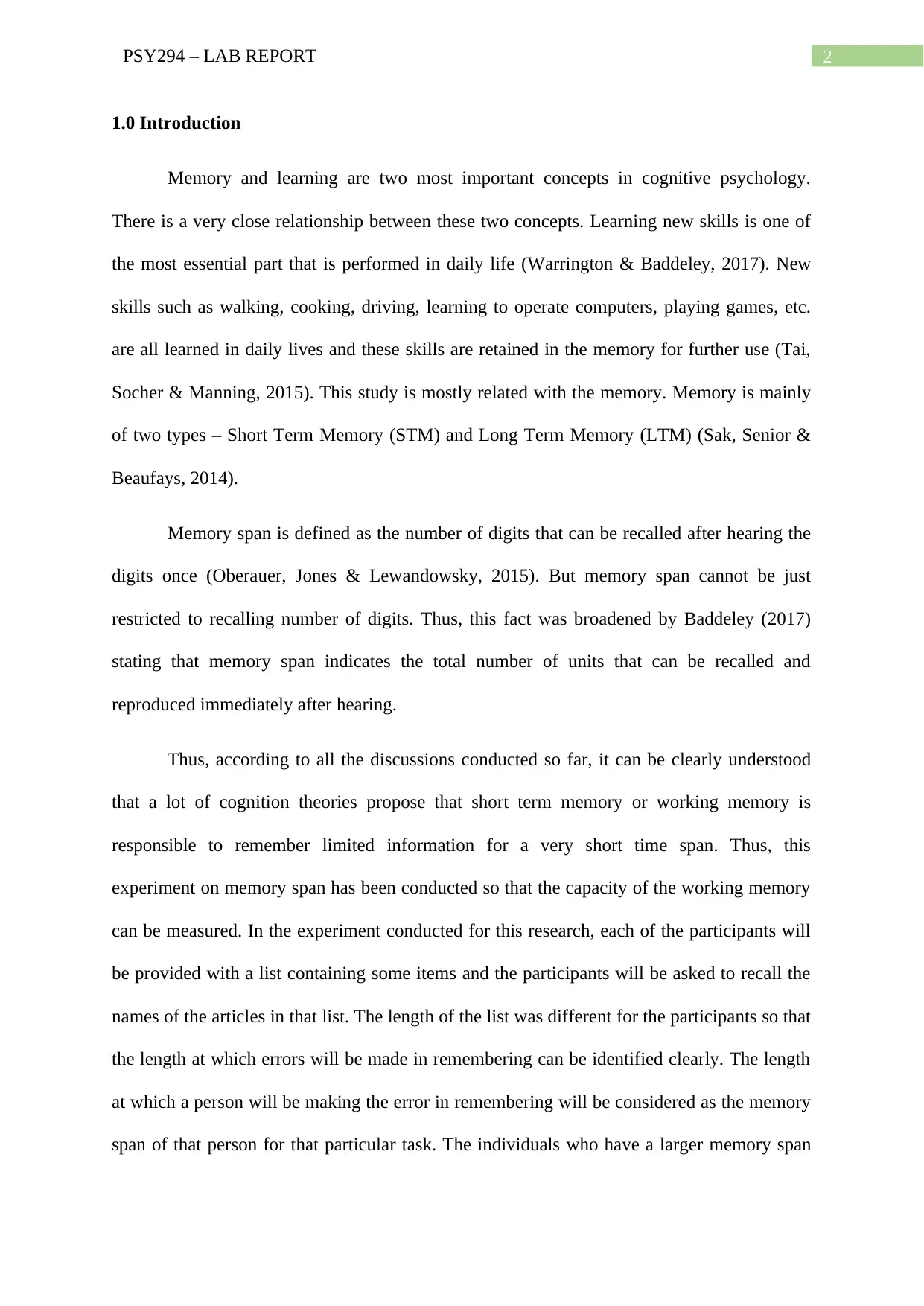
2PSY294 – LAB REPORT
1.0 Introduction
Memory and learning are two most important concepts in cognitive psychology.
There is a very close relationship between these two concepts. Learning new skills is one of
the most essential part that is performed in daily life (Warrington & Baddeley, 2017). New
skills such as walking, cooking, driving, learning to operate computers, playing games, etc.
are all learned in daily lives and these skills are retained in the memory for further use (Tai,
Socher & Manning, 2015). This study is mostly related with the memory. Memory is mainly
of two types – Short Term Memory (STM) and Long Term Memory (LTM) (Sak, Senior &
Beaufays, 2014).
Memory span is defined as the number of digits that can be recalled after hearing the
digits once (Oberauer, Jones & Lewandowsky, 2015). But memory span cannot be just
restricted to recalling number of digits. Thus, this fact was broadened by Baddeley (2017)
stating that memory span indicates the total number of units that can be recalled and
reproduced immediately after hearing.
Thus, according to all the discussions conducted so far, it can be clearly understood
that a lot of cognition theories propose that short term memory or working memory is
responsible to remember limited information for a very short time span. Thus, this
experiment on memory span has been conducted so that the capacity of the working memory
can be measured. In the experiment conducted for this research, each of the participants will
be provided with a list containing some items and the participants will be asked to recall the
names of the articles in that list. The length of the list was different for the participants so that
the length at which errors will be made in remembering can be identified clearly. The length
at which a person will be making the error in remembering will be considered as the memory
span of that person for that particular task. The individuals who have a larger memory span
1.0 Introduction
Memory and learning are two most important concepts in cognitive psychology.
There is a very close relationship between these two concepts. Learning new skills is one of
the most essential part that is performed in daily life (Warrington & Baddeley, 2017). New
skills such as walking, cooking, driving, learning to operate computers, playing games, etc.
are all learned in daily lives and these skills are retained in the memory for further use (Tai,
Socher & Manning, 2015). This study is mostly related with the memory. Memory is mainly
of two types – Short Term Memory (STM) and Long Term Memory (LTM) (Sak, Senior &
Beaufays, 2014).
Memory span is defined as the number of digits that can be recalled after hearing the
digits once (Oberauer, Jones & Lewandowsky, 2015). But memory span cannot be just
restricted to recalling number of digits. Thus, this fact was broadened by Baddeley (2017)
stating that memory span indicates the total number of units that can be recalled and
reproduced immediately after hearing.
Thus, according to all the discussions conducted so far, it can be clearly understood
that a lot of cognition theories propose that short term memory or working memory is
responsible to remember limited information for a very short time span. Thus, this
experiment on memory span has been conducted so that the capacity of the working memory
can be measured. In the experiment conducted for this research, each of the participants will
be provided with a list containing some items and the participants will be asked to recall the
names of the articles in that list. The length of the list was different for the participants so that
the length at which errors will be made in remembering can be identified clearly. The length
at which a person will be making the error in remembering will be considered as the memory
span of that person for that particular task. The individuals who have a larger memory span
⊘ This is a preview!⊘
Do you want full access?
Subscribe today to unlock all pages.

Trusted by 1+ million students worldwide
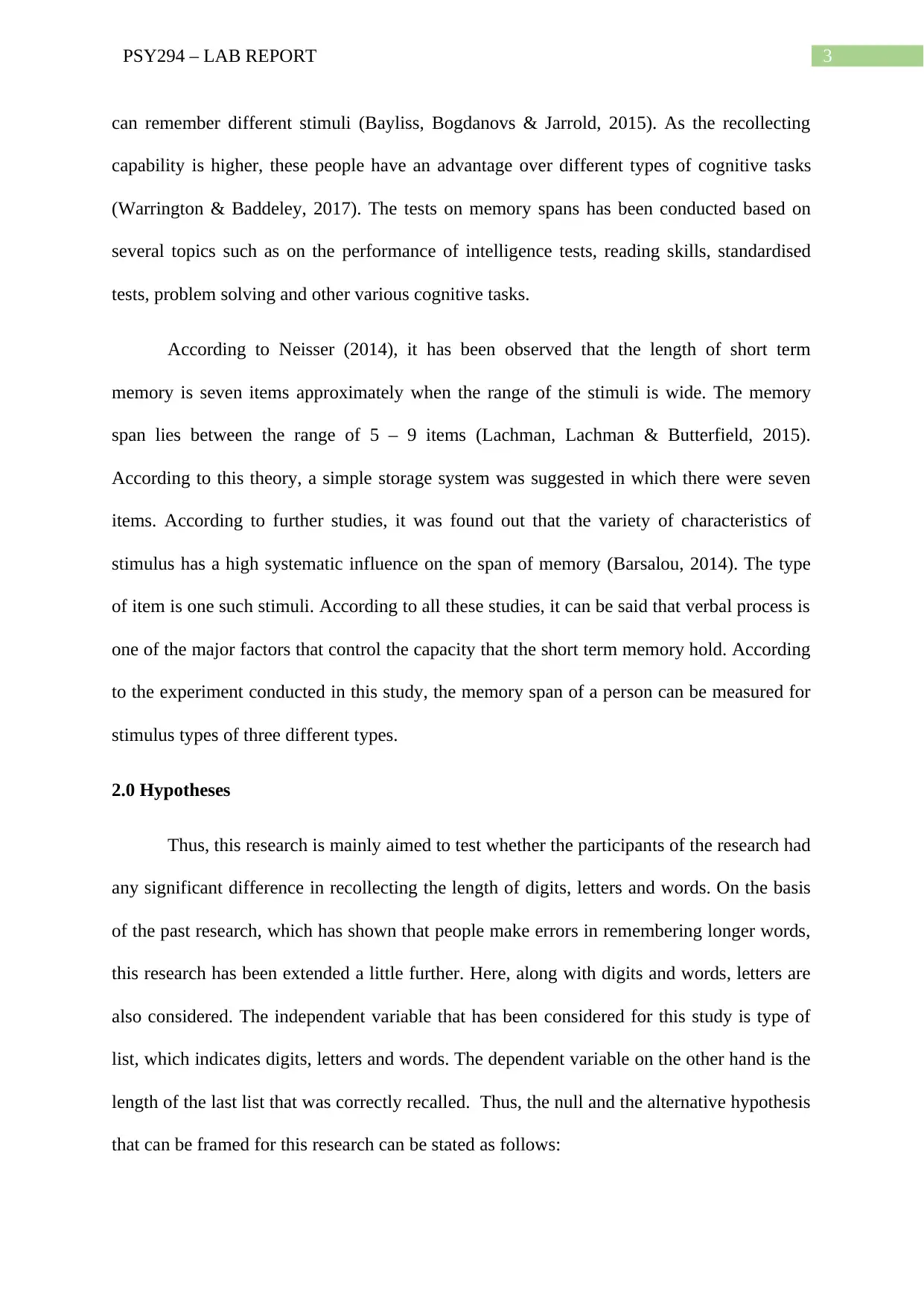
3PSY294 – LAB REPORT
can remember different stimuli (Bayliss, Bogdanovs & Jarrold, 2015). As the recollecting
capability is higher, these people have an advantage over different types of cognitive tasks
(Warrington & Baddeley, 2017). The tests on memory spans has been conducted based on
several topics such as on the performance of intelligence tests, reading skills, standardised
tests, problem solving and other various cognitive tasks.
According to Neisser (2014), it has been observed that the length of short term
memory is seven items approximately when the range of the stimuli is wide. The memory
span lies between the range of 5 – 9 items (Lachman, Lachman & Butterfield, 2015).
According to this theory, a simple storage system was suggested in which there were seven
items. According to further studies, it was found out that the variety of characteristics of
stimulus has a high systematic influence on the span of memory (Barsalou, 2014). The type
of item is one such stimuli. According to all these studies, it can be said that verbal process is
one of the major factors that control the capacity that the short term memory hold. According
to the experiment conducted in this study, the memory span of a person can be measured for
stimulus types of three different types.
2.0 Hypotheses
Thus, this research is mainly aimed to test whether the participants of the research had
any significant difference in recollecting the length of digits, letters and words. On the basis
of the past research, which has shown that people make errors in remembering longer words,
this research has been extended a little further. Here, along with digits and words, letters are
also considered. The independent variable that has been considered for this study is type of
list, which indicates digits, letters and words. The dependent variable on the other hand is the
length of the last list that was correctly recalled. Thus, the null and the alternative hypothesis
that can be framed for this research can be stated as follows:
can remember different stimuli (Bayliss, Bogdanovs & Jarrold, 2015). As the recollecting
capability is higher, these people have an advantage over different types of cognitive tasks
(Warrington & Baddeley, 2017). The tests on memory spans has been conducted based on
several topics such as on the performance of intelligence tests, reading skills, standardised
tests, problem solving and other various cognitive tasks.
According to Neisser (2014), it has been observed that the length of short term
memory is seven items approximately when the range of the stimuli is wide. The memory
span lies between the range of 5 – 9 items (Lachman, Lachman & Butterfield, 2015).
According to this theory, a simple storage system was suggested in which there were seven
items. According to further studies, it was found out that the variety of characteristics of
stimulus has a high systematic influence on the span of memory (Barsalou, 2014). The type
of item is one such stimuli. According to all these studies, it can be said that verbal process is
one of the major factors that control the capacity that the short term memory hold. According
to the experiment conducted in this study, the memory span of a person can be measured for
stimulus types of three different types.
2.0 Hypotheses
Thus, this research is mainly aimed to test whether the participants of the research had
any significant difference in recollecting the length of digits, letters and words. On the basis
of the past research, which has shown that people make errors in remembering longer words,
this research has been extended a little further. Here, along with digits and words, letters are
also considered. The independent variable that has been considered for this study is type of
list, which indicates digits, letters and words. The dependent variable on the other hand is the
length of the last list that was correctly recalled. Thus, the null and the alternative hypothesis
that can be framed for this research can be stated as follows:
Paraphrase This Document
Need a fresh take? Get an instant paraphrase of this document with our AI Paraphraser
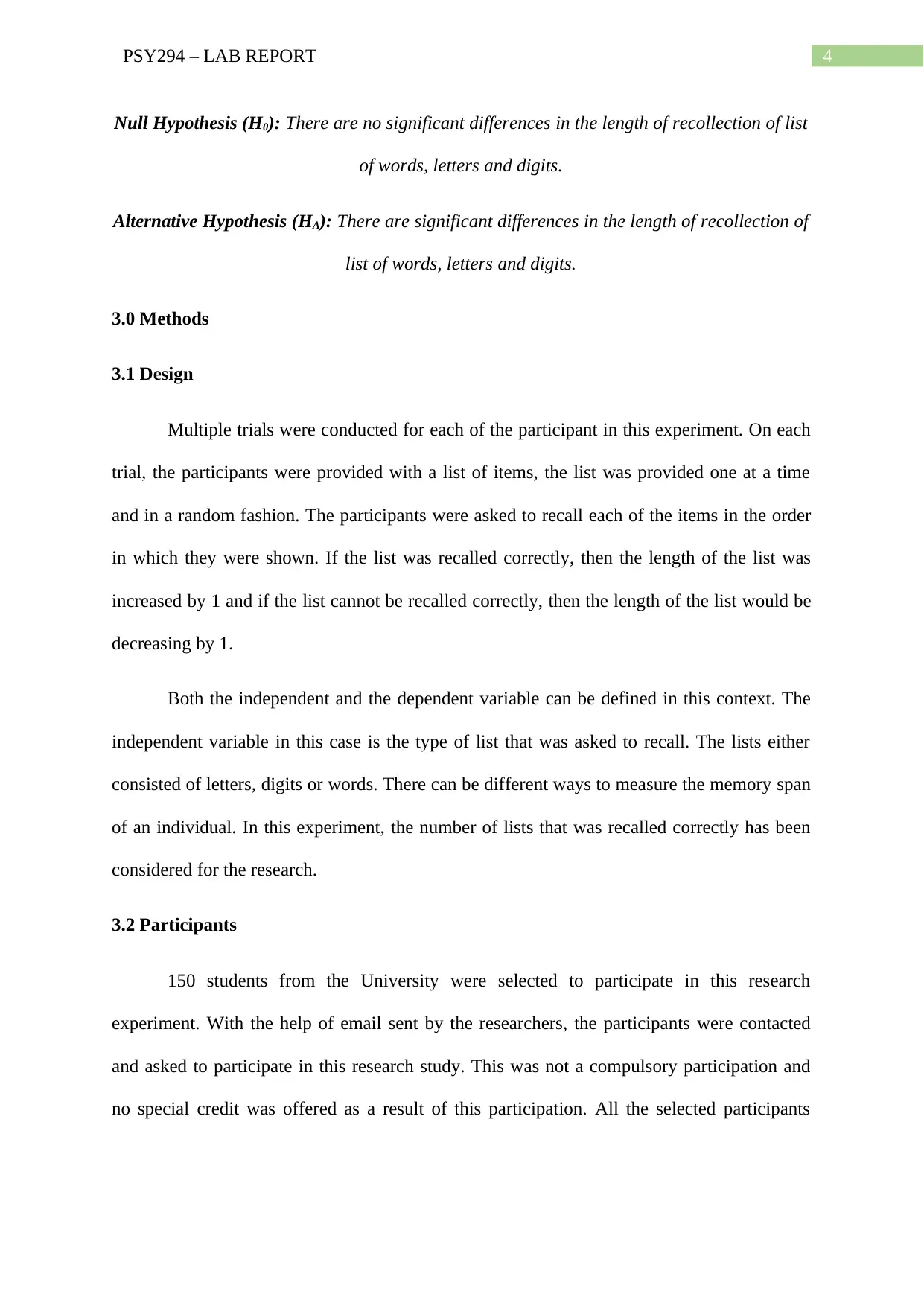
4PSY294 – LAB REPORT
Null Hypothesis (H0): There are no significant differences in the length of recollection of list
of words, letters and digits.
Alternative Hypothesis (HA): There are significant differences in the length of recollection of
list of words, letters and digits.
3.0 Methods
3.1 Design
Multiple trials were conducted for each of the participant in this experiment. On each
trial, the participants were provided with a list of items, the list was provided one at a time
and in a random fashion. The participants were asked to recall each of the items in the order
in which they were shown. If the list was recalled correctly, then the length of the list was
increased by 1 and if the list cannot be recalled correctly, then the length of the list would be
decreasing by 1.
Both the independent and the dependent variable can be defined in this context. The
independent variable in this case is the type of list that was asked to recall. The lists either
consisted of letters, digits or words. There can be different ways to measure the memory span
of an individual. In this experiment, the number of lists that was recalled correctly has been
considered for the research.
3.2 Participants
150 students from the University were selected to participate in this research
experiment. With the help of email sent by the researchers, the participants were contacted
and asked to participate in this research study. This was not a compulsory participation and
no special credit was offered as a result of this participation. All the selected participants
Null Hypothesis (H0): There are no significant differences in the length of recollection of list
of words, letters and digits.
Alternative Hypothesis (HA): There are significant differences in the length of recollection of
list of words, letters and digits.
3.0 Methods
3.1 Design
Multiple trials were conducted for each of the participant in this experiment. On each
trial, the participants were provided with a list of items, the list was provided one at a time
and in a random fashion. The participants were asked to recall each of the items in the order
in which they were shown. If the list was recalled correctly, then the length of the list was
increased by 1 and if the list cannot be recalled correctly, then the length of the list would be
decreasing by 1.
Both the independent and the dependent variable can be defined in this context. The
independent variable in this case is the type of list that was asked to recall. The lists either
consisted of letters, digits or words. There can be different ways to measure the memory span
of an individual. In this experiment, the number of lists that was recalled correctly has been
considered for the research.
3.2 Participants
150 students from the University were selected to participate in this research
experiment. With the help of email sent by the researchers, the participants were contacted
and asked to participate in this research study. This was not a compulsory participation and
no special credit was offered as a result of this participation. All the selected participants
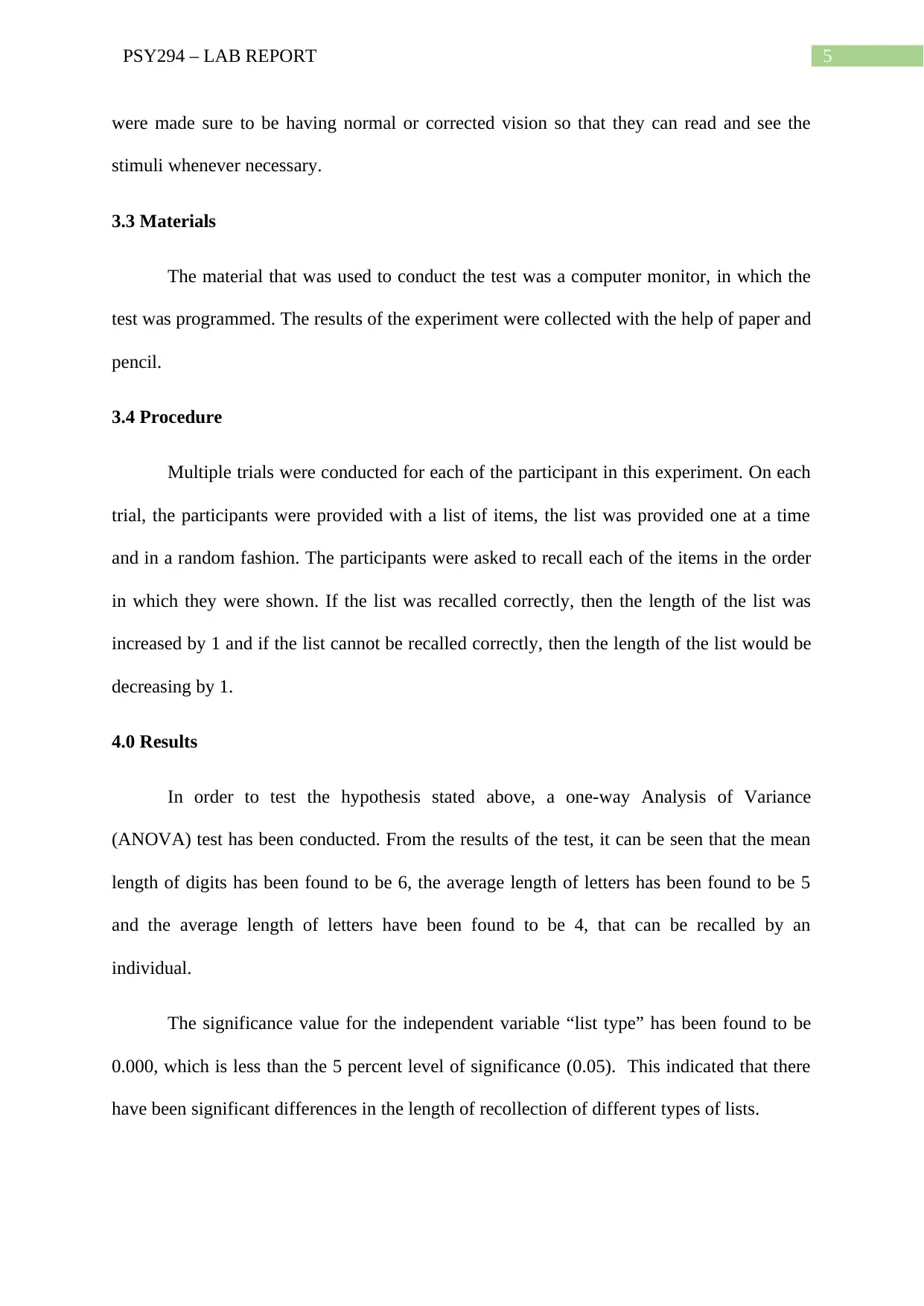
5PSY294 – LAB REPORT
were made sure to be having normal or corrected vision so that they can read and see the
stimuli whenever necessary.
3.3 Materials
The material that was used to conduct the test was a computer monitor, in which the
test was programmed. The results of the experiment were collected with the help of paper and
pencil.
3.4 Procedure
Multiple trials were conducted for each of the participant in this experiment. On each
trial, the participants were provided with a list of items, the list was provided one at a time
and in a random fashion. The participants were asked to recall each of the items in the order
in which they were shown. If the list was recalled correctly, then the length of the list was
increased by 1 and if the list cannot be recalled correctly, then the length of the list would be
decreasing by 1.
4.0 Results
In order to test the hypothesis stated above, a one-way Analysis of Variance
(ANOVA) test has been conducted. From the results of the test, it can be seen that the mean
length of digits has been found to be 6, the average length of letters has been found to be 5
and the average length of letters have been found to be 4, that can be recalled by an
individual.
The significance value for the independent variable “list type” has been found to be
0.000, which is less than the 5 percent level of significance (0.05). This indicated that there
have been significant differences in the length of recollection of different types of lists.
were made sure to be having normal or corrected vision so that they can read and see the
stimuli whenever necessary.
3.3 Materials
The material that was used to conduct the test was a computer monitor, in which the
test was programmed. The results of the experiment were collected with the help of paper and
pencil.
3.4 Procedure
Multiple trials were conducted for each of the participant in this experiment. On each
trial, the participants were provided with a list of items, the list was provided one at a time
and in a random fashion. The participants were asked to recall each of the items in the order
in which they were shown. If the list was recalled correctly, then the length of the list was
increased by 1 and if the list cannot be recalled correctly, then the length of the list would be
decreasing by 1.
4.0 Results
In order to test the hypothesis stated above, a one-way Analysis of Variance
(ANOVA) test has been conducted. From the results of the test, it can be seen that the mean
length of digits has been found to be 6, the average length of letters has been found to be 5
and the average length of letters have been found to be 4, that can be recalled by an
individual.
The significance value for the independent variable “list type” has been found to be
0.000, which is less than the 5 percent level of significance (0.05). This indicated that there
have been significant differences in the length of recollection of different types of lists.
⊘ This is a preview!⊘
Do you want full access?
Subscribe today to unlock all pages.

Trusted by 1+ million students worldwide
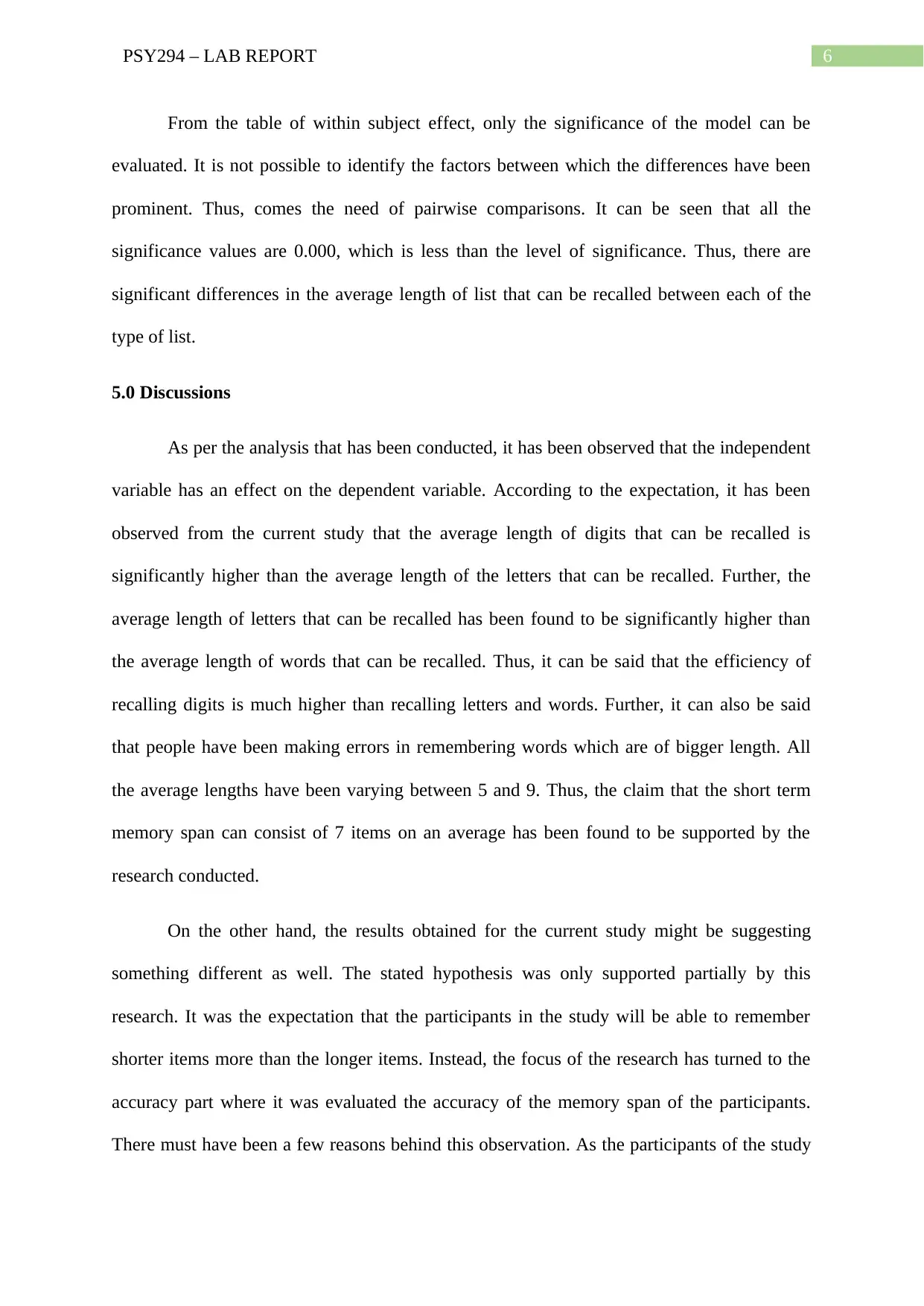
6PSY294 – LAB REPORT
From the table of within subject effect, only the significance of the model can be
evaluated. It is not possible to identify the factors between which the differences have been
prominent. Thus, comes the need of pairwise comparisons. It can be seen that all the
significance values are 0.000, which is less than the level of significance. Thus, there are
significant differences in the average length of list that can be recalled between each of the
type of list.
5.0 Discussions
As per the analysis that has been conducted, it has been observed that the independent
variable has an effect on the dependent variable. According to the expectation, it has been
observed from the current study that the average length of digits that can be recalled is
significantly higher than the average length of the letters that can be recalled. Further, the
average length of letters that can be recalled has been found to be significantly higher than
the average length of words that can be recalled. Thus, it can be said that the efficiency of
recalling digits is much higher than recalling letters and words. Further, it can also be said
that people have been making errors in remembering words which are of bigger length. All
the average lengths have been varying between 5 and 9. Thus, the claim that the short term
memory span can consist of 7 items on an average has been found to be supported by the
research conducted.
On the other hand, the results obtained for the current study might be suggesting
something different as well. The stated hypothesis was only supported partially by this
research. It was the expectation that the participants in the study will be able to remember
shorter items more than the longer items. Instead, the focus of the research has turned to the
accuracy part where it was evaluated the accuracy of the memory span of the participants.
There must have been a few reasons behind this observation. As the participants of the study
From the table of within subject effect, only the significance of the model can be
evaluated. It is not possible to identify the factors between which the differences have been
prominent. Thus, comes the need of pairwise comparisons. It can be seen that all the
significance values are 0.000, which is less than the level of significance. Thus, there are
significant differences in the average length of list that can be recalled between each of the
type of list.
5.0 Discussions
As per the analysis that has been conducted, it has been observed that the independent
variable has an effect on the dependent variable. According to the expectation, it has been
observed from the current study that the average length of digits that can be recalled is
significantly higher than the average length of the letters that can be recalled. Further, the
average length of letters that can be recalled has been found to be significantly higher than
the average length of words that can be recalled. Thus, it can be said that the efficiency of
recalling digits is much higher than recalling letters and words. Further, it can also be said
that people have been making errors in remembering words which are of bigger length. All
the average lengths have been varying between 5 and 9. Thus, the claim that the short term
memory span can consist of 7 items on an average has been found to be supported by the
research conducted.
On the other hand, the results obtained for the current study might be suggesting
something different as well. The stated hypothesis was only supported partially by this
research. It was the expectation that the participants in the study will be able to remember
shorter items more than the longer items. Instead, the focus of the research has turned to the
accuracy part where it was evaluated the accuracy of the memory span of the participants.
There must have been a few reasons behind this observation. As the participants of the study
Paraphrase This Document
Need a fresh take? Get an instant paraphrase of this document with our AI Paraphraser
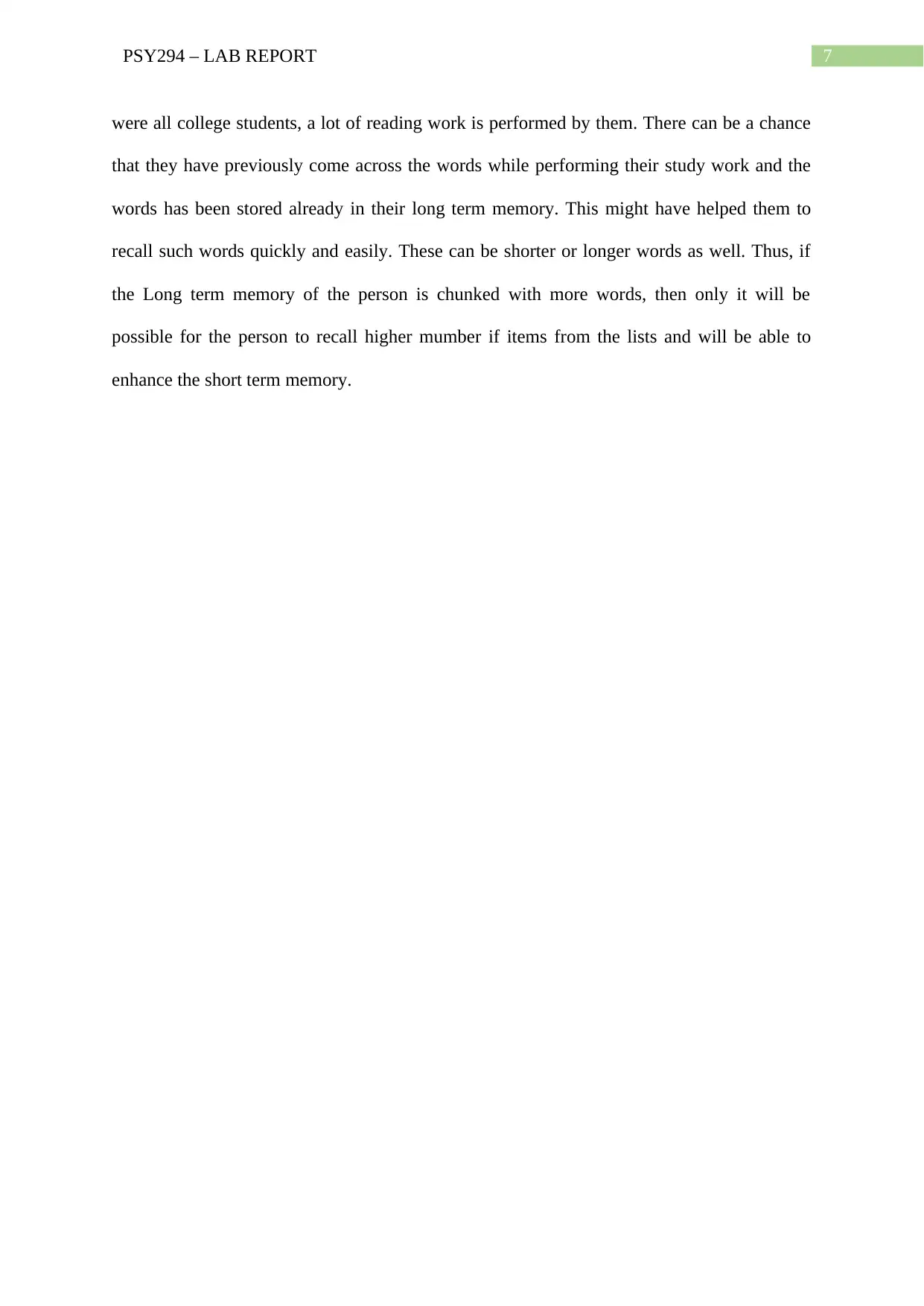
7PSY294 – LAB REPORT
were all college students, a lot of reading work is performed by them. There can be a chance
that they have previously come across the words while performing their study work and the
words has been stored already in their long term memory. This might have helped them to
recall such words quickly and easily. These can be shorter or longer words as well. Thus, if
the Long term memory of the person is chunked with more words, then only it will be
possible for the person to recall higher mumber if items from the lists and will be able to
enhance the short term memory.
were all college students, a lot of reading work is performed by them. There can be a chance
that they have previously come across the words while performing their study work and the
words has been stored already in their long term memory. This might have helped them to
recall such words quickly and easily. These can be shorter or longer words as well. Thus, if
the Long term memory of the person is chunked with more words, then only it will be
possible for the person to recall higher mumber if items from the lists and will be able to
enhance the short term memory.
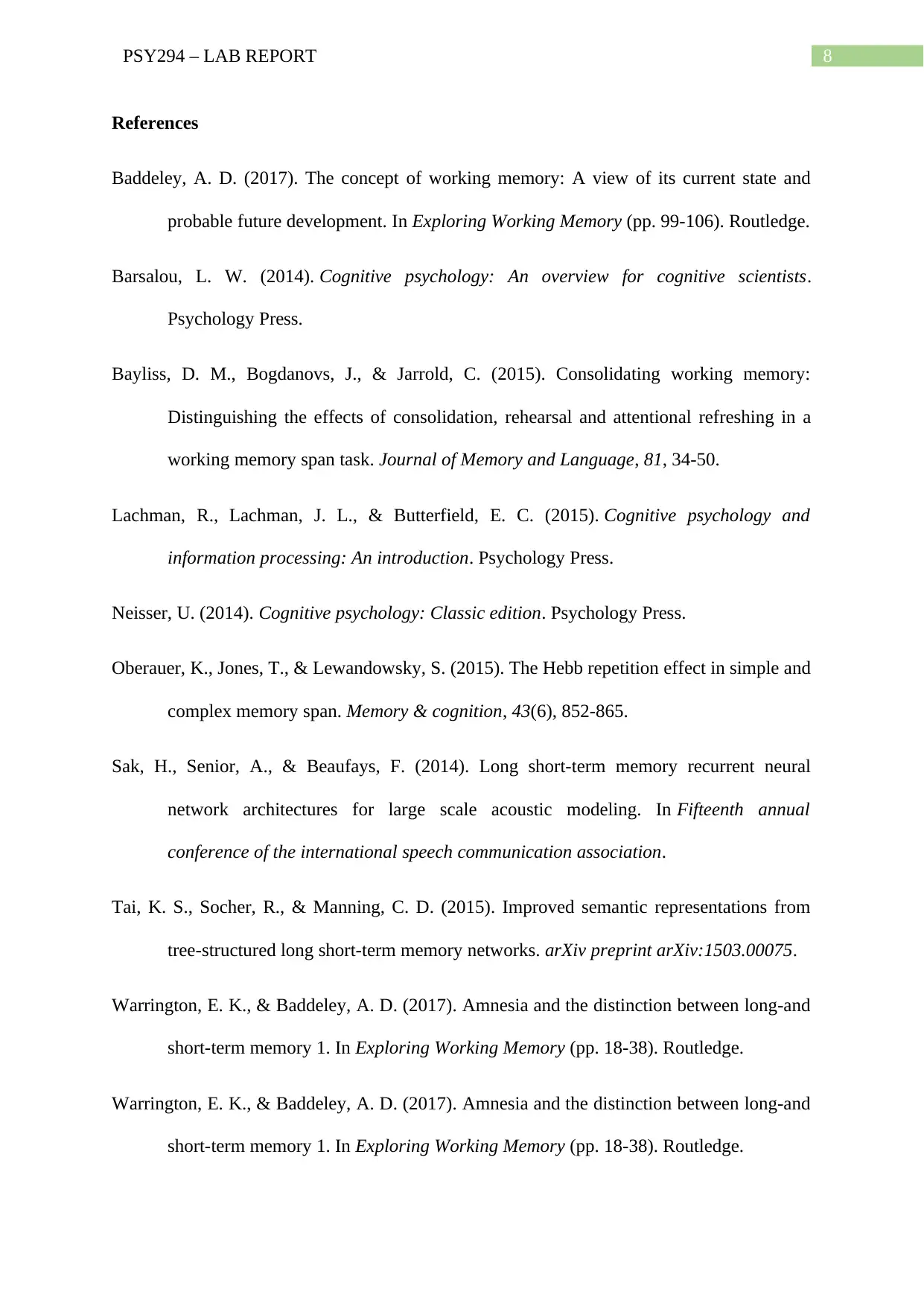
8PSY294 – LAB REPORT
References
Baddeley, A. D. (2017). The concept of working memory: A view of its current state and
probable future development. In Exploring Working Memory (pp. 99-106). Routledge.
Barsalou, L. W. (2014). Cognitive psychology: An overview for cognitive scientists.
Psychology Press.
Bayliss, D. M., Bogdanovs, J., & Jarrold, C. (2015). Consolidating working memory:
Distinguishing the effects of consolidation, rehearsal and attentional refreshing in a
working memory span task. Journal of Memory and Language, 81, 34-50.
Lachman, R., Lachman, J. L., & Butterfield, E. C. (2015). Cognitive psychology and
information processing: An introduction. Psychology Press.
Neisser, U. (2014). Cognitive psychology: Classic edition. Psychology Press.
Oberauer, K., Jones, T., & Lewandowsky, S. (2015). The Hebb repetition effect in simple and
complex memory span. Memory & cognition, 43(6), 852-865.
Sak, H., Senior, A., & Beaufays, F. (2014). Long short-term memory recurrent neural
network architectures for large scale acoustic modeling. In Fifteenth annual
conference of the international speech communication association.
Tai, K. S., Socher, R., & Manning, C. D. (2015). Improved semantic representations from
tree-structured long short-term memory networks. arXiv preprint arXiv:1503.00075.
Warrington, E. K., & Baddeley, A. D. (2017). Amnesia and the distinction between long-and
short-term memory 1. In Exploring Working Memory (pp. 18-38). Routledge.
Warrington, E. K., & Baddeley, A. D. (2017). Amnesia and the distinction between long-and
short-term memory 1. In Exploring Working Memory (pp. 18-38). Routledge.
References
Baddeley, A. D. (2017). The concept of working memory: A view of its current state and
probable future development. In Exploring Working Memory (pp. 99-106). Routledge.
Barsalou, L. W. (2014). Cognitive psychology: An overview for cognitive scientists.
Psychology Press.
Bayliss, D. M., Bogdanovs, J., & Jarrold, C. (2015). Consolidating working memory:
Distinguishing the effects of consolidation, rehearsal and attentional refreshing in a
working memory span task. Journal of Memory and Language, 81, 34-50.
Lachman, R., Lachman, J. L., & Butterfield, E. C. (2015). Cognitive psychology and
information processing: An introduction. Psychology Press.
Neisser, U. (2014). Cognitive psychology: Classic edition. Psychology Press.
Oberauer, K., Jones, T., & Lewandowsky, S. (2015). The Hebb repetition effect in simple and
complex memory span. Memory & cognition, 43(6), 852-865.
Sak, H., Senior, A., & Beaufays, F. (2014). Long short-term memory recurrent neural
network architectures for large scale acoustic modeling. In Fifteenth annual
conference of the international speech communication association.
Tai, K. S., Socher, R., & Manning, C. D. (2015). Improved semantic representations from
tree-structured long short-term memory networks. arXiv preprint arXiv:1503.00075.
Warrington, E. K., & Baddeley, A. D. (2017). Amnesia and the distinction between long-and
short-term memory 1. In Exploring Working Memory (pp. 18-38). Routledge.
Warrington, E. K., & Baddeley, A. D. (2017). Amnesia and the distinction between long-and
short-term memory 1. In Exploring Working Memory (pp. 18-38). Routledge.
⊘ This is a preview!⊘
Do you want full access?
Subscribe today to unlock all pages.

Trusted by 1+ million students worldwide
1 out of 9
Your All-in-One AI-Powered Toolkit for Academic Success.
+13062052269
info@desklib.com
Available 24*7 on WhatsApp / Email
![[object Object]](/_next/static/media/star-bottom.7253800d.svg)
Unlock your academic potential
Copyright © 2020–2025 A2Z Services. All Rights Reserved. Developed and managed by ZUCOL.


